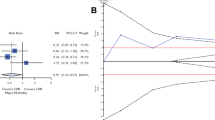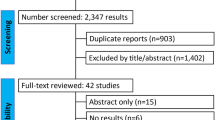Abstract
Background
Robot-assisted laparoscopic pancreaticoduodenectomy is a novel minimally invasive surgery technique, and its effectiveness and safety remain unknown in patients with borderline malignant or malignant diseases. This study aimed to prospectively evaluate the effectiveness and safety of RLPD versus open PD (OPD).
Methods
Between January 2010 and December 2013, 180 eligible patients were prospectively hospitalized for elective RLPD (n = 60) or OPD (n = 120). They were matched for tumor location, tumor type, tumor size, ASA classification, age, and sex. The main outcome measures included demographics, intraoperative variables, morbidity, postoperative recovery, and mid-term evaluation.
Results
Over the study period, the RLPD group had a significantly longer but decreasing operative time (median 410 vs. 323 min; P < 0.001), less blood loss (median 400 vs. 500 mL; P = 0.005), better nutritional status recovery, expedited off-bed return to activity (3.2 vs. 4.8 d; P < 0.001), faster resumption of bowel movement (3.6 vs. 5.2 d; P < 0.001), and shorter hospital stay (20 vs. 25 d; P = 0.002) compared to the OPD group. The two groups had similar surgical morbidities and mortality as well as R0 resection rate and number of lymph nodes resected. Among patients with pancreatic adenocarcinoma, the two groups had similar overall and disease-free survival (ACTRN12614000299606).
Conclusions
This first largest, prospective matched study demonstrated that for treating selected borderline and malignant pathologies, RLPD was associated with a significant learning curve effect and expedited postoperative recovery, but had a surgical and oncological safety profile similar to OPD.




Similar content being viewed by others
References
Whipple AO (1945) Pancreaticoduodenectomy for islet carcinoma: a five-year follow-up. Ann Surg 121:847–852
Gagner M, Lacroix A, Bolte E (1992) Laparoscopic adrenalectomy in Cushing’s syndrome and pheochromocytoma. N Engl J Med 327:1033
Gagner M, Pomp A (1994) Laparoscopic pylorus-preserving pancreatoduodenectomy. Surg Endosc 8:408–410
Giulianotti PC, Coratti A, Angelini M et al (2003) Robotics in general surgery: personal experience in a large community hospital. Arch Surg 138:777–784
Cirocchi R, Partelli S, Trastulli S et al (2013) A systematic review on robotic pancreaticoduodenectomy. Surg Oncol 22:238–246
Zureikat AH, Moser AJ, Boone BA et al (2013) 250 robotic pancreatic resections: safety and feasibility. Ann Surg 258:554–562
Lai EC, Yang GP, Tang CN (2012) Robot-assisted laparoscopic pancreaticoduodenectomy versus open pancreaticoduodenectomy—a comparative study. Int J Surg 10:475–479
Chalikonda S, Aguilar-Saavedra J, Walsh R (2012) Laparoscopic robotic-assisted pancreaticoduodenectomy: a case-matched comparison with open resection. Surg Endosc 26:2397–2402
Zhou NX, Chen JZ, Liu Q et al (2011) Outcomes of pancreatoduodenectomy with robotic surgery versus open surgery. Int J Med Robot Comp 7:131–137
Buchs NC, Addeo P, Bianco FM et al (2011) Robotic versus open pancreaticoduodenectomy: a comparative study at a single institution. World J Surg 35:2739–2746
Giulianotti PC, Sbrana F, Bianco FM et al (2010) Robot-assisted laparoscopic pancreatic surgery: single-surgeon experience. Surg Endosc 24:1646–1657
Warshaw AL, Thayer SP (2004) Pancreaticoduodenectomy. J Gastroint Surg 8:733–741
Tempero MA, Arnoletti JP, Behrman SW et al (2012) Pancreatic adenocarcinoma, Version 2.2012 featured updates to the NCCN Guidelines. J Natl Compr Cancer Netw 10:703–713
Bassi C, Dervenis C, Butturini G et al (2005) Postoperative pancreatic fistula: an international study group (ISGPF) definition. Surgery 138:8–13
Dindo D, Demartines N, Clavien P-A (2004) Classification of surgical complications: a new proposal with evaluation in a cohort of 6336 patients and results of a survey. Ann Surg 240:205–213
Greene FL (ed) (2002) AJCC cancer staging manual, vol 1. Springer, New York
Gumbs AA, Rivera AMR, Milone L et al (2011) Laparoscopic pancreatoduodenectomy: a review of 285 published cases. Ann Surg Oncol 18:1335–1341
Kuroki T, Adachi T, Okamoto T et al (2012) A non-randomized comparative study of laparoscopy-assisted pancreaticoduodenectomy and open pancreatico- duodenectomy. Hepatogastroenterol 59:570–573
Cho A, Yamamoto H, Nagata M et al (2009) Comparison of laparoscopy-assisted and open pylorus-preserving pancreaticoduodenectomy for periampullary disease. Am J Surg 198:445–449
Giulianotti PC, Addeo P, Buchs NC et al (2011) Robotic extended pancreatectomy with vascular resection for locally advanced pancreatic tumors. Pancreas 40:1264–1270
Cameron JL, Riall TS, Coleman J et al (2006) One thousand consecutive pancreaticoduodenectomies. Ann Surg 244:10–15
Gebauer F, Kloth K, Tachezy M et al (2012) Options and limitations in applying the fistula classification by the International Study Group for Pancreatic Fistula. Ann Surg 256:130–138
Dong X, Zhang B, Kang MX et al (2011) Analysis of pancreatic fistula according to the International Study Group on Pancreatic Fistula classification scheme for 294 patients who underwent pancreaticoduodenectomy in a single center. Pancreas 40:222–228
Venkat R, Puhan MA, Schulick RD et al (2011) Predicting the risk of perioperative mortality in patients undergoing pancreaticoduodenectomy: a novel scoring system. Arch Surg 146:1277–1284
Winter JM, Brennan MF, Tang LH et al (2012) Survival after resection of pancreatic adenocarcinoma: results from a single institution over three decades. Ann Surg Oncology 19:169–175
Jordan GL (1971) Surgical management of postgastrectomy problems. Arch Surg 102:251–259
Blachar A, Federle MP, Pealer KM et al (2002) Gastrointestinal complications of laparoscopic Roux-en-Y gastric bypass surgery: clinical and imaging findings I. Radiology 223:625–632
Higa KD, Ho T, Boone KB (2003) Internal hernias after laparoscopic Roux-en-Y gastric bypass: incidence, treatment and prevention. Obesity Surg 13:350–354
Fearon KCH, Ljungqvist O, Von Meyenfeldt M et al (2005) Enhanced recovery after surgery: a consensus review of clinical care for patients undergoing colonic resection. Clin Nutr 24:466–477
Caro MMM, Laviano A, Pichard C (2007) Nutritional intervention and quality of life in adult oncology patients. Clin Nutr 26:289–301
Braga M, Ljungqvist O, Soeters P et al (2009) ESPEN guidelines on parenteral nutrition: surgery. Clin Nutr 28:378–386
Kansagara D, Fu R, Freeman M et al (2011) Intensive insulin therapy in hospitalized patients: a systematic review. Ann Intern Med 154:268–282
Shimada K, Sakamoto Y, Sano T et al (2006) Prognostic factors after distal pancreatectomy with extended lymphadenectomy for invasive pancreatic adenocarcinoma of the body and tail. Surgery 139:288–295
Slidell MB, Chang DC, Cameron JL et al (2008) Impact of total lymph node count and lymph node ratio on staging and survival after pancreatectomy for pancreatic adenocarcinoma: a large, population-based analysis. Ann Surg Oncol 15:165–174
Zeh HJ, Zureikat AH, Secrest A et al (2012) Outcomes after robot-assisted pancreaticoduodenectomy for periampullary lesions. Ann Surg Oncol 19:864–870
Sohn TA, Yeo CJ, Cameron JL et al (2000) Resected adenocarcinoma of the pancreas—616 patients: results, outcomes, and prognostic indicators. J Gastroint Surg 4:567–579
Sargent DJ, Wieand HS, Haller DG et al (2005) Disease-free survival versus overall survival as a primary end point for adjuvant colon cancer studies: individual patient data from 20,898 patients on 18 randomized trials. J Clin Oncol 23(34):8664–8670
Oettle H, Post S, Neuhaus P et al (2007) Adjuvant chemotherapy with gemcitabine vs observation in patients undergoing curative-intent resection of pancreatic cancer: a randomized controlled trial. JAMA 297(3):267–277
Acknowledgments
The authors thank all of the volunteer participants and their families. Shi Chen and Jiang-zhi Chen certify that each had a “first author” role equally. Qian Zhan and Cheng-hong Peng also contributed equally, and both should be considered as co-corresponding author. The authors thank Cheng-hui Ma and Zhi-hong Han for their surgery image.
Disclosure
Shi Chen, Jiang-zhi Chen, Qian Zhan, Xia-xing Deng, Bai-yong Shen, Cheng-hong Peng, and Hong-wei Li declares no conflict of interest.
Author information
Authors and Affiliations
Corresponding author
Additional information
Drs Shi Chen and Jiang-zhi Chen contributed equally to this work, and both should be considered first author. Qian Zhan and Cheng-hong Peng also contributed equally, and both should be considered as co-corresponding author.
Electronic supplementary material
Below is the link to the electronic supplementary material.
Rights and permissions
About this article
Cite this article
Chen, S., Chen, JZ., Zhan, Q. et al. Robot-assisted laparoscopic versus open pancreaticoduodenectomy: a prospective, matched, mid-term follow-up study. Surg Endosc 29, 3698–3711 (2015). https://doi.org/10.1007/s00464-015-4140-y
Received:
Accepted:
Published:
Issue Date:
DOI: https://doi.org/10.1007/s00464-015-4140-y




